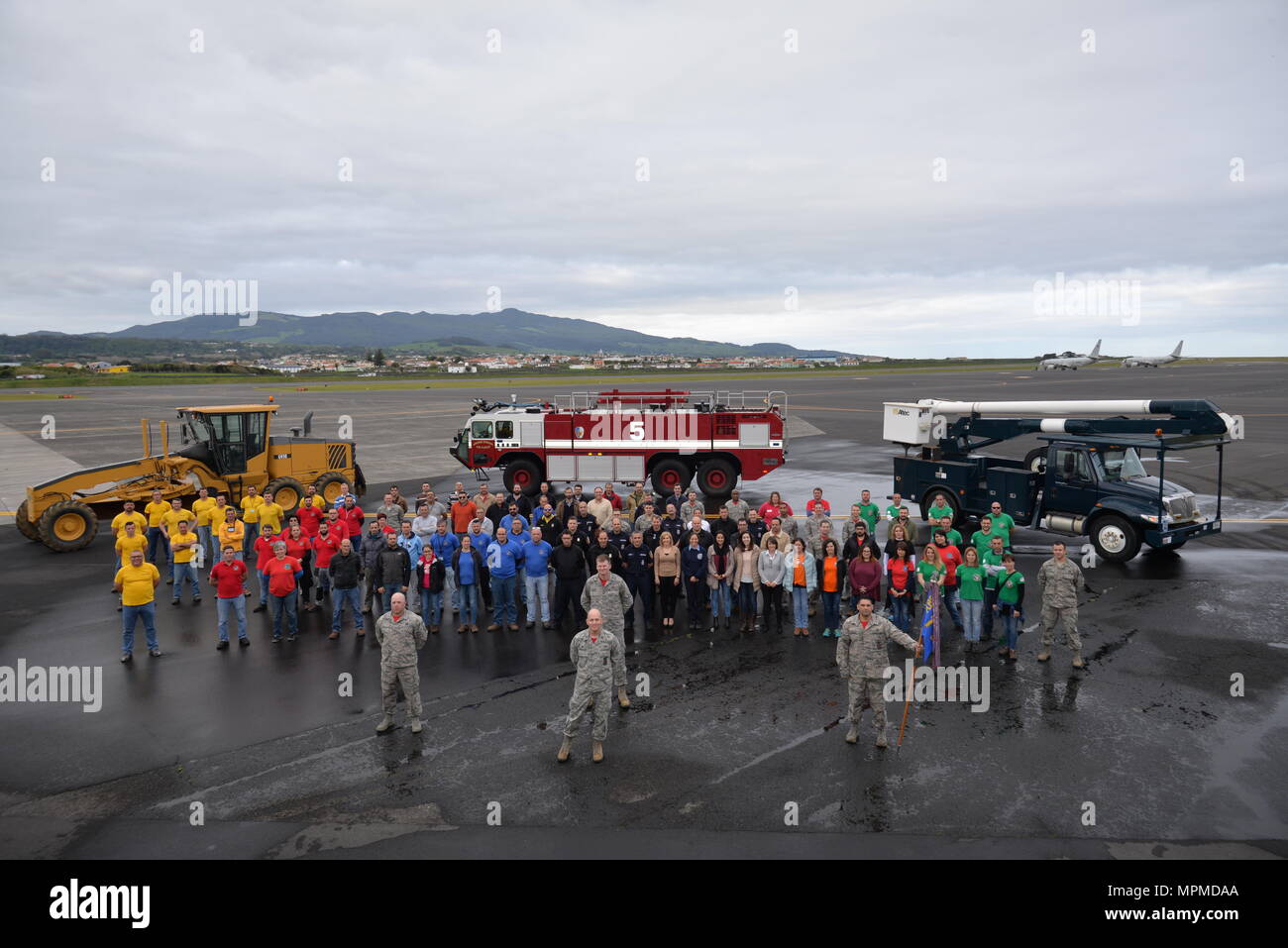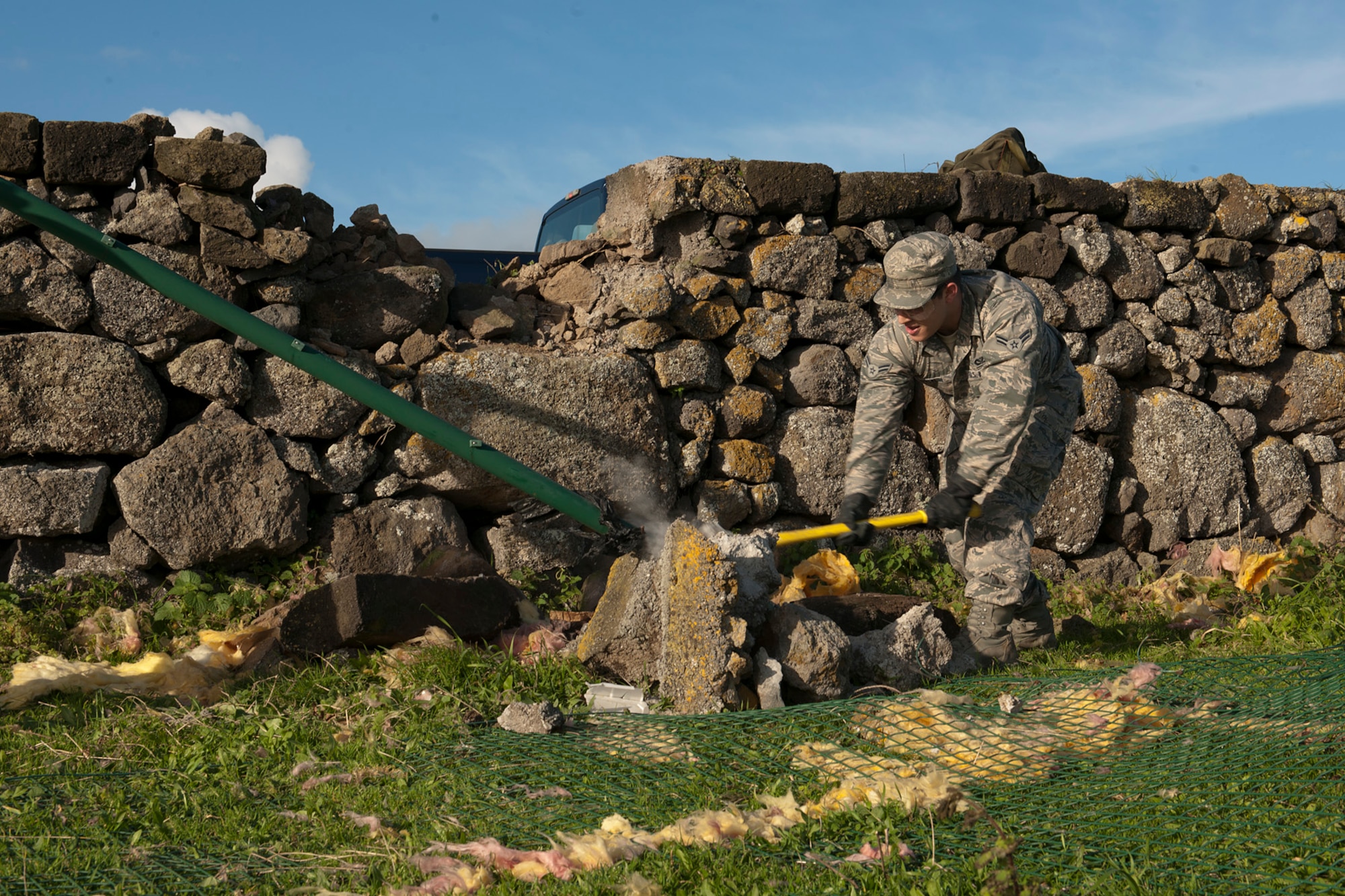Lajes Field Azores - Coordinates: 38°45′45″N 27°6′21″W / 38.76250°N 27.10583°W / 38.76250; -27.10583 Coordinates: 38°45′45″N 27°6′21″W / 38.76250°N 27.10583°W / 38.76250; -27.10583
Lajes is a civil parish in the municipality of Praia de Vitória in the Azores on the Portuguese island of Terceira. In 2011, the population was 3,744.
Lajes Field Azores
It is the second most populated parish in the municipality of Praia da Vitória. It includes Fundões, Caldeira, Canada da Caldeira, Canada das Fontainhas, Canada das Vinhas, Canada do Poço, Lajedo, Lajes, Picão, Rebtão and Santa Rita.
Lajes (praia Da Vitória)
Lajes is best known for being the location of Portuguese Air Force Base No. 4, which is used for military, small island missions, as well as scheduled and chartered flights from North America and mainland Europe. The U.S. military has a multi-year contract with the Portuguese government at Logis Airport, which is home to the U.S. 65th Air Base Wing (65 ABW).
There is a reference to the navigator Piero de Barcellos, who was one of the first settlers in the area, dating back to April 3, 1507.
The date of construction of the original church is unknown. It was burnt down in 1587 by flamboyant privateers.
And Cáida da Praia was destroyed during the earthquake of 1614, which caused great destruction to the lodges and the neighboring neighbourhood.
View Of Lajes Do Pico, Azores
Due to its natural beauty, Logis was the preferred residence of the rich and noble families, which led to it being called A Madrid dos Açores ('Madrid of the Azores').
Many estates and lands supported the rest of the Tercera, earning the name Celeiro da Tercera ('breadbasket of the Tercera'). There are many references to the quantity and quality of produce in the region, including fruit and wine, as well as silk production. Lajes is located on a vast fertile plain, divided by rows of hedgerows and where many old main houses still reflect the importance of agriculture and the prosperity of the island's traditional families.
At one time many of the modern roads that crisscross the parish today were used by farmers to haul goods, usually using large Ramo Grande oxen, pulling large carts.

Wood was usually transported and burned to keep warm in the winter or to cook food in a clay oven.
Chief Master Sgt. Of The Air Force Visits Lajes >
u.s. Air Forces In Europe & Air Forces Africa
> Article DisplayAlong with Santa Cruz, the lodges also became a site, during and after World War II, for British and American troops stationed at Base Area No. 4, supporting development and providing a vibrant economic base for the parish and region.
Lajes is located on the northern coast of Terceira, bordered by the parishes of Vila Nova and Sao Bras to the west, Santa Cruz to the east and Fontenas to the south. Most of the parish (over half) is occupied by Air Base No. 4, and Air Force personnel barracks/homes are located on the base (including American and Portuguese soldiers). The rest of the base is actually in the neighboring civil parish of Santa Cruz.
The western border is defined by the Ribeira da Areia which crosses inland, reaching the neighborhoods of Vila Nova and Sao Bras. Border Lorais, to Fundões, and part again inland, crossing Rua do Terreiro, Rua das Covas, Rua dos Fundões and Rua Padre Gregório B. Rocha, before reaching Picão. The border passes through the pastures in the interior, before aligning with the regional road of Santa Luzia, and running perpendicular to the regional airport, cutting the runway to Santa Rita, to the coast of Punta dos Carneros.
Besides Ribeira da Areia and Ribeira dos Pães, underground branches of Ribeira do Marques (which cross the airport/airport) cross the parish.
Next Generation Radar (dopler) Site, About 20 Miles From Lajes Field, Azores
Lajes has a humid subtropical climate (Cfa) with hot summers and cold winters. Precipitation is typical of the Mediterranean throughout the year. The influence of the Gulf Stream helps limit extreme maxima and minima, with an overall temperature difference of only 27.2 °C (49 °F). Lajes is very cloudy all year round. Humidity is also high throughout the year.
"Moynes 1991/2020 Portugal (LAJES)". Baseline climate means (1991–2020) from stations around the world. Weather Retrieved 7 May 2022.
Due to the importance and significance of the regional airport, the economy of the lodges has a symbiotic relationship with the activities at Airbase No. 4. Most of the support staff at the center are residents of the lodges, and many services in the parish support the international needs of the resident. Although most services are provided on a service basis, there is still an impact on the local community, with support personnel living in the parish and investing their money in the local economy. At the same time, it is common for foreign service to support the local, off-duty economy.

Local activities include carpenter shops, instructional services for farmers, car and mechanical garages, video, graphic and promotional services and financial institutions, including branches of national and regional banks (Montepieu, Banif, etc.). In addition, many shops, mini markets, fruit and food stalls serve the local residents as well as bakeries, butchers, and hairdressers.
Force Support Facilities' Map
Lajes has several elementary schools with the main one located in Aldeia Nova. It has two churches, the main one of which dates back to the 16th century. This church was destroyed in the earthquakes of 1614 and 1841 and partially destroyed in the earthquake of January 1, 1980. Another small church is located in Caboco. For airport service to Lagos, Brazil, see Lagos Airport. For the civil use of the airport, see Lajes Airport.
This article requires additional citations for verification. Please help improve this article by adding references to reliable sources. Inappropriate content can be challenged and removed. Searching Source Lodges Field" – News · Newspapers · Books · Scholars · JSTOR (April 2008) (Learn how and who to remove this template message)
A variety of US Air Force aircraft are based at Lagos, the airport is used as a stopover point for aircraft traveling between the United States and Europe.
38°45′43″N 027°05′27″W / 38.76194°N 27.09083°W / 38.76194; -27.09083 Coordinates: 38°45′43″N 027°05′27″W / 38.76194°N 27.09083°W / 38.76194; -27.09083
B 2 Spirit Aircraft Conduct Hot Pit Refueling At Lajes Field > U.s. Strategic Command > News Article View
Lajes Field or Lajes Air Base (pronounced [ˈlaʒɨʒ]; Portuguese: Base Aérea das Lajes), officially designated air base no. 4 (Base Aérea Nº 4, BA4) (IATA: TER, ICAO: LPLA), is a multi-use airport near Lajes and 15 kilometers (9.3 mi) northeast of Angra do Heroísmo.
On Terceira Island in the Azores, Portugal. It is home to Portuguese Air Force Base Aérea Nº4 and the Azores Air Zone Command (Portuguese: Comando da Zona Aérea dos Açores), a detachment unit of the United States Air Force (operated by the United States Air Force's 65th Air Base Group. states in Europe). - African Air Force), and a regional air passenger terminal. about 3,680 km (2,290 mi) east of New York City and about 1,600 km (990 mi) west of Lisbon, Portugal; The center is strategically located in the North Atlantic Ocean between North America and Europe.
Lajes Field began in 1928, when Portuguese Army Lieutenant Colonel Eduardo Gómez da Silva wrote a report on the possibility of building an airport at Lajes Field for the Air Service of that branch (Portuguese: Aeronáutica Militar). However, the location of Achada on the island of São Miguel was chosen instead of the construction of the arena. In 1934, Achada Airfield was condemned for its inadequate pumping and bad weather, which led to the construction of a dirt landing strip and a small group of accommodation facilities in lodges by the Portuguese Army.
See also: Portugal during World War II, Operation Alacrity, and North Atlantic air ferry route in World War II
Yesterday Members Of The 65th Air Base Wing Supported An Open House Event Hosted By The Portuguese Air Force Partners At Lajes Field. Cooperation And Solidarity With The Portuguese And U.s Air
During World War II, the airport's designation was changed to Airbase No. 4 and the Portuguese government extended the runway, sending troops and supplies to Tercera, including Gloucester Gladiator fighters. Military activity in the Azores increased in 1942, as Gladiators began to be used to support Allied convoys, on reconnaissance missions and meteorological missions. In addition, the first 52 Portuguese Junkers arrived in July 1942 to fly cargo missions.
By 1943, British and American armed forces were allowed to establish rights in Portugal. Within a month of entering Tercera in October 1943, the RAF had installed perforated steel planes on the runway at Logis Field, allowing the RAF to begin patrolling. The first attack on a German U-boat took place in November, sinking the submarine; This attack was followed by a dozen more U-boat attacks by February 1944, after which German forces were cleared from British and American patrol areas.
On 1 December 1943, British and American military representatives at RAF Lajes Field signed a joint agreement outlining the roles and responsibilities of the United States Army Air Force (USAAF) and USN Navy (USN) at Lajes Field.
The agreement establishes guidelines and restrictions on the carriage of aircraft and the transport of aircraft to Europe through the logistics field.
Naval Air Facility Lajes Field Azores Patch
In return, the United States agreed to help the British improve and expand the facilities at the lodges. Air Transport Command began landing transport planes
Sig p365 tulster holster, sig p365 iwb holster, sig holsters p365, sig p365 sas holster, sig p365 xl holster, sig p365 hybrid holster, appendix holster sig p365, safariland holster sig p365, sig p365 belt holster, sig p365 holster, sig p365 purse holster, sig sauer p365 holster

0 Comments